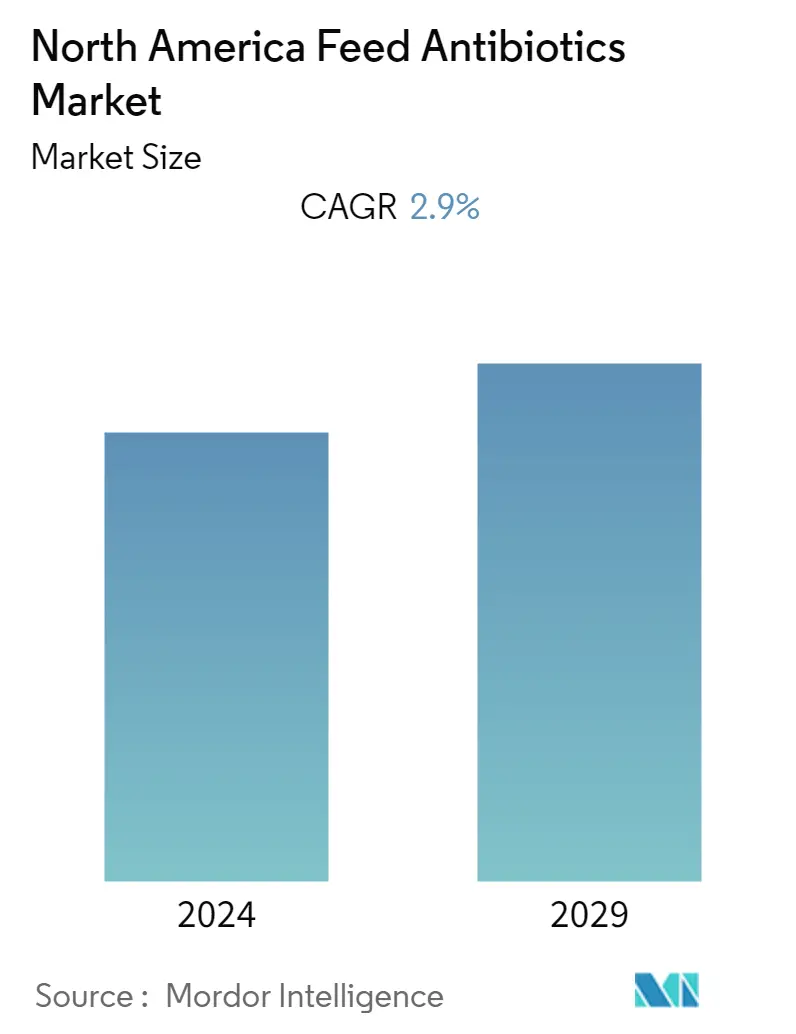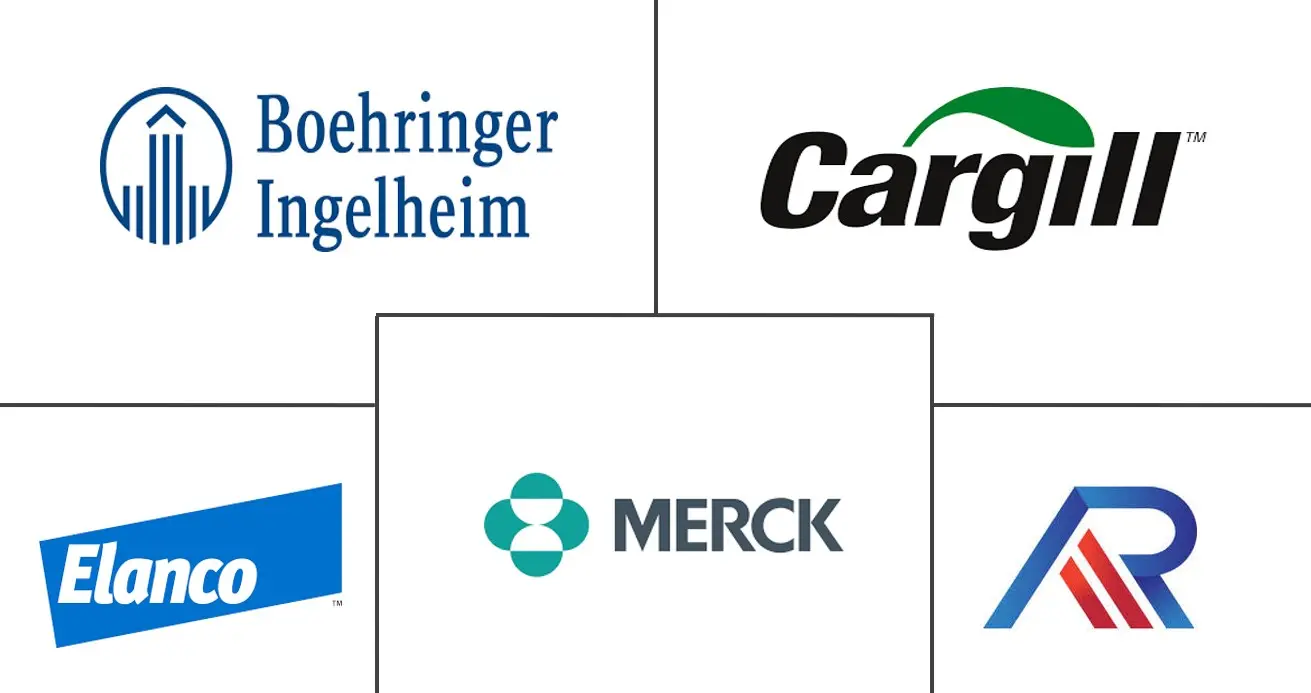Market Size of North America Feed Antibiotics Industry

| Study Period | 2019 - 2029 |
| Base Year For Estimation | 2023 |
| Forecast Data Period | 2024 - 2029 |
| Historical Data Period | 2019 - 2022 |
| CAGR | 2.90 % |
Major Players
*Disclaimer: Major Players sorted in no particular order |
North America Feed Antibiotics Market Analysis
The North America feed antibiotics market is projected to register a CAGR of 2.9% during the forecast period(2020-2025). Industrialization, increasing animal disease, expansion of the meat market are the major factors for attractiveness in this region. The feed antibiotics are used in the livestock industry to obtain a high feed efficiency rate and to prevent and treat disease in the herds of animals or in an individual animal. Tetracyclines, Penicillins, sulfonamide, macrolides are some of the major antibiotics used in the livestock industry. The United States dominates the market owing to the higher demand for meat and the mass production of livestock. The usage of the Veterinary Feed Directive (VFD) drug in farm animal feed requires authorization by a licensed veterinarian, according to the agency's VFD regulations. However, the ban on the use of antibiotics, apart from therapeutic use in the United States, has hampered the market growth. Some of the leading players in the market are Merck & Co., Inc., Elanco, American Regent, Inc., Boehringer Ingelheim Mexico., and Alltech Inc.
North America Feed Antibiotics Industry Segmentation
Antibiotics in livestock are used to treat and prevent disease in the livestock. Despite the increasing concern regarding the antimicrobial resistance in humans due to the use of antibiotics in livestock, meat consumption is increasing every year. This increases the demand for meat rising the production with an increase in the treatment of livestock with antibiotics.
| Type | |
| Tetracyclines | |
| Penicillins | |
| Sulfonamides | |
| Macrolides | |
| Aminoglycosides | |
| Cephalosporins | |
| Others |
| Animal Type | |
| Ruminants | |
| Poultry | |
| Swine | |
| Aquaculture | |
| Others |
| Geography | |
| United States | |
| Mexico | |
| Canada | |
| Rest of North America |
North America Feed Antibiotics Market Size Summary
The North America feed antibiotics market is experiencing growth driven by factors such as industrialization, rising animal diseases, and the expansion of the meat market. Feed antibiotics are essential in the livestock industry to enhance feed efficiency and prevent or treat diseases in animals. Key antibiotics used include tetracyclines, penicillins, sulfonamides, and macrolides. The United States leads the market due to high meat demand and extensive livestock production. However, regulatory restrictions on antibiotic use, except for therapeutic purposes, pose challenges to market expansion. Major industry players like Merck & Co., Inc., Elanco, and Boehringer Ingelheim are actively involved in the market, employing strategies such as mergers, acquisitions, and research and development investments to strengthen their market position.
The increasing consumption of meat, particularly beef, in the United States is a significant factor propelling the feed antibiotics market. The growing cattle and poultry populations necessitate quality feed, including antibiotics, to ensure animal health and productivity. The market is further supported by advancements such as the approval of new animal-only antibiotics by companies like Elanco, which help maintain animal well-being without affecting human antibiotic treatment outcomes. The market is consolidated, with a few major players holding a significant share, and these companies are focusing on expanding their operations and enhancing their product offerings to meet the rising demand for feed antibiotics in the region.
North America Feed Antibiotics Market Size - Table of Contents
-
1. MARKET DYNAMICS
-
1.1 Market Overview
-
1.2 Market Drivers
-
1.3 Market Restraints
-
1.4 Porter's Five Force Analysis
-
1.4.1 Bargaining Power of Suppliers
-
1.4.2 Bargaining Power of Buyers/Consumers
-
1.4.3 Threat of New Entrants
-
1.4.4 Threat of Substitute Products
-
1.4.5 Intensity of Competitive Rivalry
-
-
-
2. MARKET SEGMENTATION
-
2.1 Type
-
2.1.1 Tetracyclines
-
2.1.2 Penicillins
-
2.1.3 Sulfonamides
-
2.1.4 Macrolides
-
2.1.5 Aminoglycosides
-
2.1.6 Cephalosporins
-
2.1.7 Others
-
-
2.2 Animal Type
-
2.2.1 Ruminants
-
2.2.2 Poultry
-
2.2.3 Swine
-
2.2.4 Aquaculture
-
2.2.5 Others
-
-
2.3 Geography
-
2.3.1 United States
-
2.3.2 Mexico
-
2.3.3 Canada
-
2.3.4 Rest of North America
-
-
North America Feed Antibiotics Market Size FAQs
What is the current North America Feed Antibiotics Market size?
The North America Feed Antibiotics Market is projected to register a CAGR of 2.9% during the forecast period (2024-2029)
Who are the key players in North America Feed Antibiotics Market?
Merck & Co., Inc. , Elanco, American Regent, Inc., Boehringer Ingelheim Mexico. and Alltech Inc. are the major companies operating in the North America Feed Antibiotics Market.

